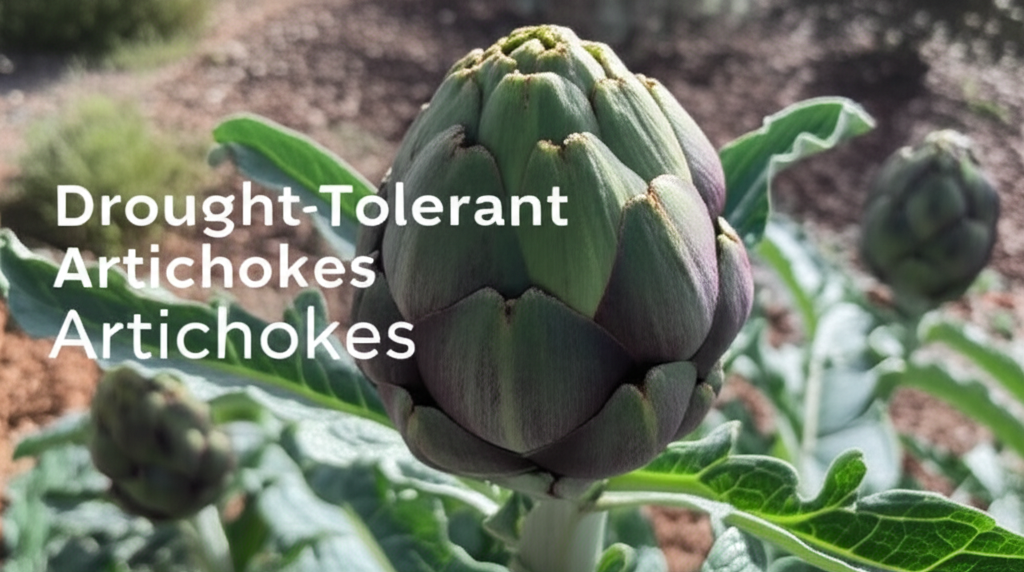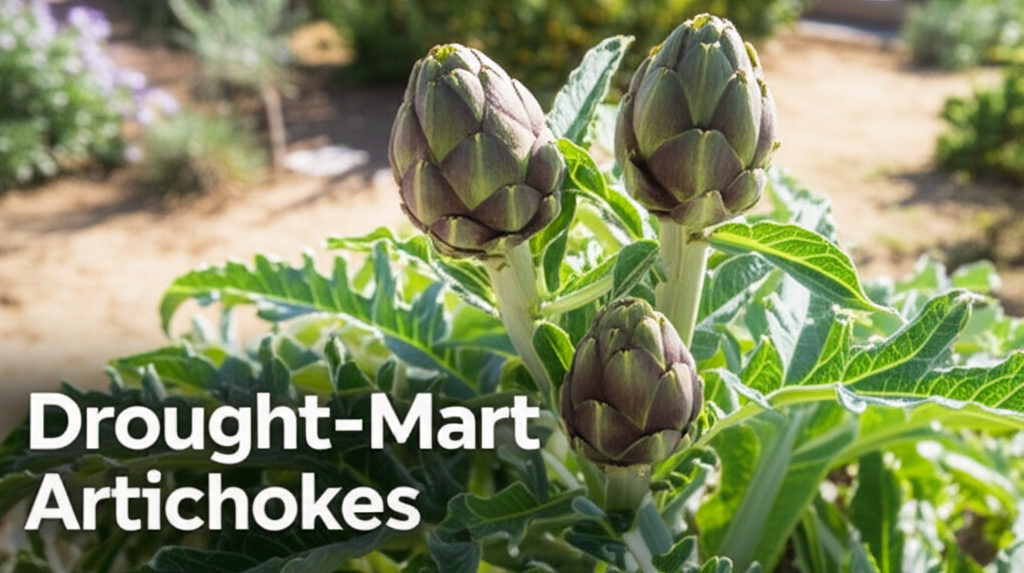The Allure of Globe Artichokes in a Water-Wise World
Globe artichokes (Cynara cardunculus var. scolymus) are more than just a culinary delicacy; they are a statement in any garden. Their majestic presence, with silvery-green, architectural foliage and striking purple flower buds, adds a unique visual appeal. However, in an era increasingly defined by water scarcity and the rise of drought-tolerant gardening, the globe artichoke presents a fascinating case study. Can these substantial plants, often perceived as needing ample moisture, truly thrive in arid conditions? The answer is a resounding yes, with the right approach. Understanding their origins, their specific needs, and implementing strategic watering techniques are key to cultivating these impressive vegetables in a water-wise garden.
Understanding the Globe Artichoke: From Wild Ancestor to Garden Gem

The globe artichoke is a perennial thistle, originating from the Mediterranean region, an area historically known for its dry summers. This heritage provides a crucial clue to their resilience. Their wild ancestor, the cardoon (Cynara cardunculus), is notoriously drought-tolerant. While cultivated globe artichokes have been bred for larger, more tender edible portions, they retain a significant portion of their wild progenitor’s hardiness.
The plant’s physical characteristics are also indicative of its adaptability:
- Deep taproot system: Artichokes develop extensive root systems that can delve deep into the soil, accessing moisture reserves that shallower-rooted plants cannot reach.
- Silvery, fuzzy leaves: The fine hairs (trichomes) on their leaves help to reflect sunlight, reducing water loss through transpiration. They also trap a layer of air, providing insulation against extreme temperatures.
These inherent traits make the globe artichoke a surprisingly suitable candidate for drought-tolerant gardening, provided certain cultivation practices are followed.
Key Facts and Comparison: Globe Artichokes vs. Other Common Vegetables
To truly appreciate the drought tolerance of globe artichokes, it’s helpful to compare them with more commonly grown garden vegetables. This comparison highlights their advantages in water-wise landscapes.
| Vegetable | Typical Water Needs (per week) | Drought Tolerance | Root System |
|---|---|---|---|
| Globe Artichoke | 1-2 inches | High (once established) | Deep taproot |
| Tomato | 1-2 inches | Moderate | Fibrous, spreads wide |
| Cucumber | 1-2 inches | Low to Moderate | Shallow, spreads wide |
| Lettuce | 1-2 inches | Low | Very shallow |
| Carrot | 1 inch | Moderate | Taproot, but not as deep as artichoke |
| Zucchini | 1-2 inches | Moderate | Fibrous, spreads wide |
As you can see, once established, globe artichokes require a similar amount of water to many popular vegetables, but their ability to access deeper water sources gives them a significant advantage during dry spells.
Cultivating Globe Artichokes for Drought Tolerance: A Strategic Approach
Successful drought-tolerant globe artichoke cultivation hinges on smart planting, soil preparation, and watering techniques. It’s not about eliminating water, but about using it more efficiently.
1. Site Selection: The Foundation of Success
Choosing the right location is paramount. Globe artichokes thrive in:
- Full sun: At least 6-8 hours of direct sunlight per day.
- Well-drained soil: They loathe waterlogged roots, so good drainage is non-negotiable.
- Protection from strong winds: Their large leaves and flower stalks can be easily damaged.
Consider planting them in a location where they can benefit from any available runoff or where you can easily implement targeted watering.
2. Soil Preparation: Building Resilience from the Ground Up
Rich, well-draining soil is the ideal environment for globe artichokes. Before planting, incorporate generous amounts of organic matter.
- Compost: Improves soil structure, water retention (without becoming waterlogged), and nutrient availability.
- Aged manure: Adds nutrients and improves soil health.
- Perlite or coarse sand: Can be added to heavy clay soils to improve drainage.
A slightly alkaline to neutral soil pH (6.5-7.5) is generally preferred.
3. Planting and Establishment: The Crucial Early Stages
The establishment phase is critical for developing that deep root system.
- Planting Time: In temperate climates, plant either in early spring or fall. Fall planting allows them to establish roots before the heat of summer.
- Spacing: Give them plenty of room; mature plants can spread up to 4-6 feet wide and 3-4 feet tall. Space them accordingly to allow for airflow and prevent overcrowding.
- Initial Watering: Water deeply and consistently after planting to encourage root establishment. This initial period is where consistent moisture is most important.
4. Watering Strategies: Efficiency is Key
Once established (typically after the first year), globe artichokes become significantly more drought-tolerant. The goal is to water deeply but infrequently.
- Deep Watering: When you do water, ensure the water penetrates several inches into the soil. This encourages the roots to grow downwards.
- Frequency: In hot, dry weather, they might need watering once a week or every ten days. In cooler, more humid conditions, less frequent watering might be sufficient.
- Drip Irrigation: This is the most efficient method as it delivers water directly to the root zone, minimizing evaporation.
- Soaker Hoses: Another excellent option for targeted watering.
- Avoid Overhead Watering: Especially in the evening, as this can promote fungal diseases.
5. Mulching: The Drought Gardener’s Best Friend
Mulching is indispensable for drought-tolerant gardening. A thick layer of organic mulch around the base of your artichoke plants offers numerous benefits:
- Moisture Retention: Helps keep the soil moist by reducing evaporation.
- Temperature Regulation: Keeps the soil cooler in summer and warmer in winter.
- Weed Suppression: Reduces competition for water and nutrients.
Apply a 3-4 inch layer of mulch, keeping it a few inches away from the main stem to prevent rot. Straw, wood chips, or shredded bark are excellent choices.
Harvesting and Continued Care for Optimal Production
Harvesting globe artichokes at the right time not only yields delicious results but also influences the plant’s energy reserves for future growth and drought resilience.
When to Harvest
The ideal time to harvest is when the buds are firm, plump, and the scales are tightly closed. Just before the bud begins to open is the prime window. Snip the bud with a sharp knife, leaving about an inch of stem attached.
Post-Harvest Care
After harvesting the main bud, the plant will often produce smaller side shoots. It’s generally recommended to leave some of these on the plant to continue the growing season, but for plants you are actively trying to conserve water with, you might consider pinching off smaller side shoots to redirect energy.
Overwintering and Pruning
In colder climates, globe artichokes require winter protection. In warmer climates, they are generally evergreen.
- Pruning: After the main harvest, or in late fall before winter, cut back the foliage to about 6-12 inches from the ground. This encourages new growth in spring.
- Winter Protection (Colder Climates): In regions with freezing temperatures, after cutting back the foliage, mound soil or mulch around the base of the plant. Some gardeners also cover the entire plant with straw or burlap.
Pros and Cons of Globe Artichokes in Drought-Tolerant Gardens
Like any plant, globe artichokes have advantages and disadvantages when considering them for water-wise gardening.
| Pros | Cons |
|---|---|
| High drought tolerance once established: Leverages deep root systems. | Requires consistent watering during establishment: First year is critical. |
| Architectural beauty: Adds significant aesthetic value. | Large space requirement: Needs ample room to grow. |
| Edible and ornamental: Dual purpose in the garden. | Can be susceptible to pests and diseases: Especially in humid conditions or if overwatered. |
| Long harvest period: Can provide produce for several months. | Requires good drainage: Poorly draining soil can be fatal. |
| Perennial: Once planted, they return year after year, reducing replanting effort. | Can be sensitive to extreme cold: May need winter protection in some zones. |
Troubleshooting Common Issues in Drought-Tolerant Artichoke Gardens
Even with a drought-tolerant approach, challenges can arise.
- Yellowing Leaves: Can indicate underwatering, but also overwatering or poor drainage. Check soil moisture levels first. If the soil is dry, water deeply. If it’s soggy, address drainage issues.
- Leaf Scorch: In extreme heat and drought, the leaf edges might turn brown and crispy. This is a sign of stress, and increased watering or providing temporary shade can help.
- Pests: Aphids and slugs can be an issue. Companion planting with strong-smelling herbs like rosemary or mint can deter some pests. Manual removal or insecticidal soap can be used if necessary.
Conclusion: Globe Artichokes – A Rewarding Choice for the Water-Conscious Gardener
Globe artichokes are a testament to the fact that beautiful and productive gardening does not always require copious amounts of water. Their Mediterranean heritage, combined with intelligent cultivation practices, allows them to flourish in water-wise landscapes. By focusing on deep watering, excellent drainage, effective mulching, and careful site selection, gardeners can successfully incorporate these magnificent plants into their drought-tolerant gardens. The reward is not only the stunning visual impact but also the unique culinary experience of harvesting your own delicious globe artichokes, knowing you’ve done so with a mindful approach to water conservation. They are a truly rewarding choice, proving that resilience and beauty can indeed go hand in hand.


